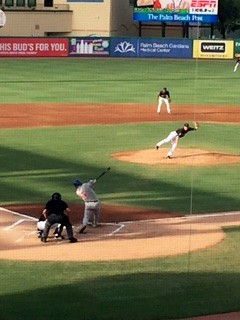For the past two years, I have worked as an independent contractor, keeping score of minor league baseball games in the Florida State League for Baseball Info Solutions, a private business that collects a variety of data for Major League Baseball franchises. There has been a proliferation of the use of metrics in professional baseball and BIS is on the cutting edge. You can visit their web site at http://www.baseballinfosolutions.com for more information.
The Florida State League is a Class A-Advanced minor league, which puts it a notch below Class AA on the professional baseball pyramid. The season starts in April and ends on Labor Day. I usually attend games at Roger Dean Stadium in Jupiter, Fl., the Spring Training home of the St. Louis Cardinals and Florida Marlins. The Palm Beach Cardinals and Jupiter Hammerheads (Marlins) are in the league, along with the St. Lucie Mets, a few exits north of Jupiter on Interstate 95, the Tampa Yankees, Clearwater Phillies, Fort Myers Twins, Daytona Beach Tortugas (Reds) and Florida Fire Frogs (Braves) to name a few of the teams.
The Florida State League is known as a “Pitcher’s League”, which means we get to see some of the best pitching prospects advancing through the minor leagues. It’s a highly competitive league with a fast pace of play, aided by the use of a pitch clock (15 seconds are allowed for each pitch.) Batting averages are low, few players hit .300, home runs are a premium and speed and defense are utilized effectively. The average game time of two-and-a-half hours is well below the major league norm. Occasionally, we get to see major league players on injury rehabilitation assignments before they re-join their teams.
The score keeping job is a paid gig, but the best perk is free admission to the games. The score keepers are a diverse group that share a common passion for baseball. Two score keepers are assigned to each game, so we sit together to compare notes. We are tasked with collecting a variety of data for each plate appearance. We track the pitch sequence (balls, strikes swinging, strikes taken, foul balls), the velocity of each ball in play (hard, medium or soft), the location of each ball in play (medium ground ball to the shortstop) and the outcome of each play (ground-out, shortstop to first-baseman.) We collect the data manually at the game and upload with a custom software program to BIS headquarters after the game. We are graded on the accuracy of each report.
The crowd attendance at most games is less than 500 people, fewer than 200 at some, but in late June when the New York Mets promoted Tim Tebow, the Heisman Trophy winning quarterback from the University of Florida to Port St. Lucie, a dramatic spike in attendance occurred around the Florida State League. In the second half of the season, games featuring Tebow and the St. Lucie Mets drew record crowds of 2,000 or more at every ballpark. Much of the attendance bump was fueled by Florida Gators’ fans who wanted to watch their grid-iron hero in action in his first season of professional baseball.
Tebow is a marketing dream: famous, handsome, athletic, hard-working, articulate and media-savvy. In the Florida State League, he was a phenomenon. He signed autographs, conversed with the fans, gave interviews to the press and made it look easy. When a player comes to the plate in the Florida State League, at best, he is greeted with a smattering of polite applause from a sparse crowd, but when Tebow’s name was announced, the large crowd shouted out his name and gave a loud roar. Among the things that happened during the season was a story-book incident involving Tebow and a an autistic child that actually resulted in Tebow hitting a home run for the child.
Tebow demonstrated that he was a better ballplayer than some two-sport wannabes like Michael Jordan, even though he hadn’t played baseball since high school. He was a respectable outfielder and served as an occasional designated hitter. He got off to a torrid start, and one time was batting over .300 with a long streak of reaching base safely in consecutive games. But, eventually his numbers came back to earth and he ended the half season with a pedestrian .225 batting average, five home runs and a combined on-base and slugging percentage around .650. The Mets honored Tebow with his own bobble head doll as a give-away item for the fans at the last home game of the season.
I enjoyed watching Tebow play, but in general, I have become a fan of minor league baseball. It is a pure experience watching young men compete at this level to see how far they can advance up the food chain of professional baseball and fulfill their dreams of reaching the major leagues. Most of the players in the Florida State League do not have large contracts and are not over-paid.
We get to see some good prospects every summer. The best prospect I saw this season was Vlad Guerrero, Jr., son of Vlad, with the Dunedin Blue Jays. He’s a five-tool player that swings the bat like his daddy with a rifle arm at third base. I like the fast-paced action and silly promotions that entertain fans between innings. It is cheap, old-fashioned family entertainment for young and old, where you can still buy a dog and a beer for less than $10, and it was the perfect place for Tim Tebow.
